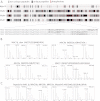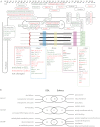On marathons and Sprints: an integrated quantitative proteomics and transcriptomics analysis of differences between slow and fast muscle fibers
- PMID: 22210690
- PMCID: PMC3433927
- DOI: 10.1074/mcp.M111.010801
On marathons and Sprints: an integrated quantitative proteomics and transcriptomics analysis of differences between slow and fast muscle fibers
Abstract
Skeletal muscle tissue contains slow as well as fast twitch muscle fibers that possess different metabolic and contractile properties. Although the distribution of individual proteins in fast and slow fibers has been investigated extensively, a comprehensive proteomic analysis, which is key for any systems biology approach to muscle tissues, is missing. Here, we compared the global protein levels and gene expression profiles of the predominantly slow soleus and fast extensor digitorum longus muscles using the principle of in vivo stable isotope labeling with amino acids based on a fully lysine-6 labeled SILAC-mouse. We identified 551 proteins with significant quantitative differences between slow soleus and fast extensor digitorum longus fibers out of >2000 quantified proteins, which greatly extends the repertoire of proteins differentially regulated between both muscle types. Most of the differentially regulated proteins mediate cellular contraction, ion homeostasis, glycolysis, and oxidation, which reflect the major functional differences between both muscle types. Comparison of proteomics and transcriptomics data uncovered the existence of fiber-type specific posttranscriptional regulatory mechanisms resulting in differential accumulation of Myosin-8 and α-protein kinase 3 proteins and mRNAs among others. Phosphoproteome analysis of soleus and extensor digitorum longus muscles identified 2573 phosphosites on 973 proteins including 1040 novel phosphosites. The in vivo stable isotope labeling with amino acids-mouse approach used in our study provides a comprehensive view into the protein networks that direct fiber-type specific functions and allows a detailed dissection of the molecular composition of slow and fast muscle tissues with unprecedented resolution.
Figures






Similar articles
-
Single Muscle Fiber Proteomics Reveals Distinct Protein Changes in Slow and Fast Fibers during Muscle Atrophy.J Proteome Res. 2018 Oct 5;17(10):3333-3347. doi: 10.1021/acs.jproteome.8b00093. Epub 2018 Sep 5. J Proteome Res. 2018. PMID: 30142977
-
Proteomic analysis of slow- and fast-twitch skeletal muscles.Proteomics. 2005 Jul;5(11):2896-906. doi: 10.1002/pmic.200401181. Proteomics. 2005. PMID: 15981298
-
Mouse soleus (slow) muscle shows greater intramyocellular lipid droplet accumulation than EDL (fast) muscle: fiber type-specific analysis.J Muscle Res Cell Motil. 2017 Apr;38(2):163-173. doi: 10.1007/s10974-017-9468-6. Epub 2017 Mar 9. J Muscle Res Cell Motil. 2017. PMID: 28281032
-
Slow or fast: Implications of myofibre type and associated differences for manifestation of neuromuscular disorders.Acta Physiol (Oxf). 2023 Aug;238(4):e14012. doi: 10.1111/apha.14012. Epub 2023 Jul 21. Acta Physiol (Oxf). 2023. PMID: 37306196 Review.
-
Broader implications of SILAC-based proteomics for dissecting signaling dynamics in cancer.Expert Rev Proteomics. 2014 Dec;11(6):713-31. doi: 10.1586/14789450.2014.971115. Epub 2014 Oct 27. Expert Rev Proteomics. 2014. PMID: 25345469 Review.
Cited by
-
Simultaneous Pathoproteomic Evaluation of the Dystrophin-Glycoprotein Complex and Secondary Changes in the mdx-4cv Mouse Model of Duchenne Muscular Dystrophy.Biology (Basel). 2015 Jun 10;4(2):397-423. doi: 10.3390/biology4020397. Biology (Basel). 2015. PMID: 26067837 Free PMC article.
-
Signatures of muscle disuse in spaceflight and bed rest revealed by single muscle fiber proteomics.PNAS Nexus. 2022 Jun 11;1(3):pgac086. doi: 10.1093/pnasnexus/pgac086. eCollection 2022 Jul. PNAS Nexus. 2022. PMID: 36741463 Free PMC article.
-
Differences between fast and slow muscles in scallops revealed through proteomics and transcriptomics.BMC Genomics. 2018 May 22;19(1):377. doi: 10.1186/s12864-018-4770-2. BMC Genomics. 2018. PMID: 29783952 Free PMC article.
-
Mass Spectrometry-Based Proteomic Technology and Its Application to Study Skeletal Muscle Cell Biology.Cells. 2023 Nov 1;12(21):2560. doi: 10.3390/cells12212560. Cells. 2023. PMID: 37947638 Free PMC article. Review.
-
Resistance exercise: a mighty tool that adapts, destroys, rebuilds and modulates the molecular and structural environment of skeletal muscle.Phys Act Nutr. 2023 Jun;27(2):78-95. doi: 10.20463/pan.2023.0021. Epub 2023 Jun 30. Phys Act Nutr. 2023. PMID: 37583075 Free PMC article.
References
-
- Schiaffino S., Reggiani C. (1996) Molecular diversity of myofibrillar proteins: gene regulation and functional significance. Physiol. Rev. 76, 371–423 - PubMed
-
- Booth F. W., Thomason D. B. (1991) Molecular and cellular adaptation of muscle in response to exercise: perspectives of various models. Physiol. Rev. 71, 541–585 - PubMed
-
- Pette D., Staron R. S. (2000) Myosin isoforms, muscle fiber types, and transitions. Microsc. Res. Tech. 50, 500–509 - PubMed
-
- Dhoot G. K., Perry S. V. (1979) Distribution of polymorphic forms of troponin components and tropomyosin in skeletal muscle. Nature 278, 714–718 - PubMed
-
- MacLennan D. H., Toyofuku T., Lytton J. (1992) Structure-function relationships in sarcoplasmic or endoplasmic reticulum type Ca2+ pumps. Ann. N.Y. Acad. Sci. 671, 1–10 - PubMed
Publication types
MeSH terms
Substances
LinkOut - more resources
Full Text Sources

